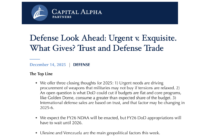Welcome to the CavasShips Podcast with Christopher P. Cavas and Chris Servello…a weekly podcast looking at naval and maritime events and issues of the day – in the US, across the seas and around the world. This Week…China. While most military and strategic eyes this week are focused on Russia, no one is forgetting the larger, so-called “pacing threat” – China. But while everyone talks about the rise of China and in particular the People’s Liberation Army Navy, is there a plan to deal with it? What’s the strategy? We’ll talk to a key thinker, Thomas Mahnken, head of the CSBA strategic think tank.
In this Week’s Squawk Chris Servello challenges obstacles to strategic thinking.
Please send us feedback by DM’ing @CavasShips or @CSSProvision or you can email chriscavas@gmail.com or cservello@defaeroreport.com.
This Week’s Naval Round Up:
Widespread Russian naval and air exercises continued in multiple theaters. Garnering perhaps the most attention was a flock of warships from Russia’s Northern and Baltic Fleets, who moved into the Atlantic – via both the English Channel and routes north of Scotland – to a location more than 200 nautical miles southwest of Ireland in the North Atlantic. After vigorous protests from the Irish government and its fishing industry Russia agreed on January 30 to move the exercises from a location within Ireland’s exclusive economic zone. Multiple Russian military aircraft also sortied to support the exercises, and most aircraft and ship movements were shadowed by NATO planes and ships. Another large exercise is taking place in the western Pacific involving Russian forces based around Vladivostok, while more ships are in the Mediterranean and Baltic Seas. The movements have been widely covered by Russian state and international media as the crisis along the Ukraine border continues.
In the Mediterranean, NATO warships gathered in the Adriatic Sea Feb. 2 for a photo op during Vigilance Activity Neptune Strike. Centered on the carriers HARRY S TRUMAN and Italy’s CAVOUR, the group showcased a multinational escort force that included ships from Italy, Norway and Turkey along with US warships.
The French carrier CHARLES DE GAULLE got underway from Toulon February 1 to begin a three-month cruise dubbed Mission Clemenceau 2022. The carrier and her multinational task group, including the US destroyer ROSS, are expected to join with the TRUMAN and CAVOUR for a period of three-carrier operations.
And in the Red Sea, the US-led International Maritime Exercise 2022 began on January 31. The largest maritime exercise in the Middle East is running into mid-February and combines a series of Cutlass Express exercises with east African nations into a much larger series of maneuvers. More than 50 ships and personnel from 60 nations are taking part, including Israeli forces. The overall exercise, called IMX, is led by the US Fifth Fleet with deputy commanders from Pakistan and the United Kingdom.
The US agreed to send a warship and F-35 fighter jets to the United Arab Emirates after a third Houthi missile attack on Abu Dhabi on January 31. The warship is the destroyer USS COLE, well known for the October 2000 terrorist attack on the ship while moored in the harbor of Aden, Yemen. The COLE is on a regular deployment in the area and was at Bahrain in the Persian Gulf when the US made its commitment on Feb. 2. COLE, like all US destroyers and cruisers, is equipped with the highly effective Aegis combat system for air defense.
In Tonga, the Australian Navy’s big assault ship HMAS ADELAIDE appears to still be alongside at Nuku’alofa dealing with a major power failure. The 27,000-tonne ship arrived January 26 and offloaded 88 tons of supplies but then suffered a major electrical power outage. The Australian Navy said emergency power was still available on the ship but the service has provided little further public information. The ship has been in service since 2015 and is one of two Spanish-designed assault ships in the Australian Navy. Meanwhile, naval ships from a variety of countries have been to Tonga, hit on January 15 by a nearby volcanic eruption. Navies that have contributed to Tonga relief include New Zealand, the US, the United Kingdom, China and Japan.
Servello Squawk:
In our last segment Tom Mahnken expertly covered the need for a maritime strategy focused on deterring…and if necessary defeating China. And perhaps most importantly he laid out the challenges and perils of competing without a strategy.
But why is it so hard for Americans to think strategically and carry out strategic planning and action? This wasn’t always the case, in fact we used to lead the world in this type of thinking and action.
It would seem, the first step to righting this rudderless ship, as Tom discusses in his Proceedings article, is to admit that we have a problem.
Let’s admit that false budget breakdowns of equal 1/3 portions for each service don’t demand or reward strategic thinking.
Let’s admit that spending several quarters of the fiscal year without a budget doesn’t demand or reward strategic thinking.
And let’s admit that accepting parochial service chief guidance as strategy does not promote or reward strategic thinking.
I don’t know if its chicken or egg…if a lack of strategic thinking drives bad behavior or if bad behavior stifles creativity and intellect. I’m not sure if it matters or if I care which comes first.
Until we abandon hobby horse politics, parochial service infighting and a can kicking approach to problem solving—there is no way we will develop, yet alone execute a meaningful strategy to deter and defeat our adversaries.
Let’s call out the obstacles to strategic thinking and get serious about problem solving. Time is not on our side.




